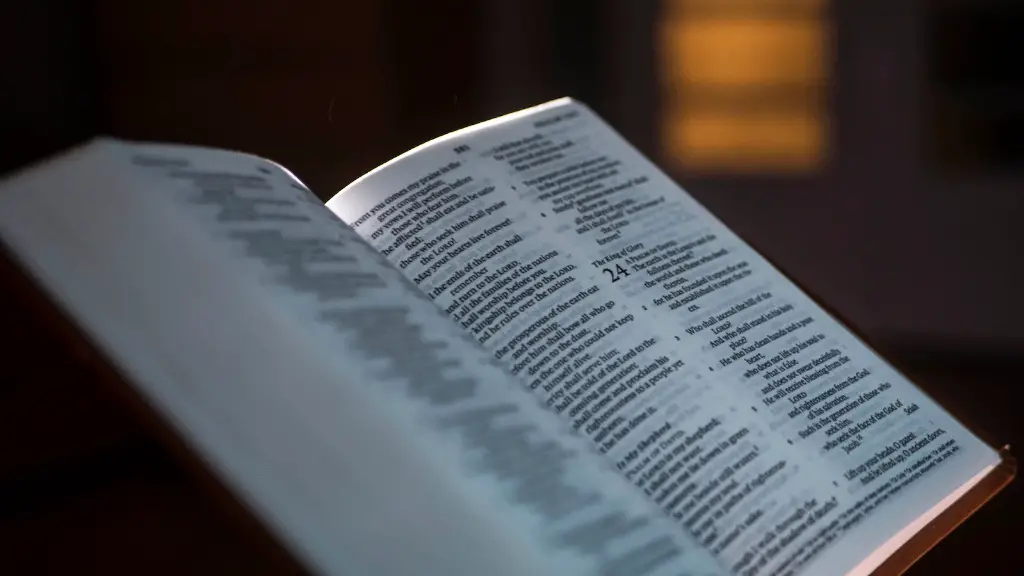What Does The Bible Say About Mixing Races Kjv?
In the Bible, there are several passages that discuss the issue of racial mixing. The issue has been discussed in the Old Testament, mainly in the book of Deuteronomy, which addresses the laws given to the Israelites when they entered the Promised Land. In these passages, the concern over interracial marriages (specifically within the Israelite nation) is clear. However, when read within context, it is important to remember that these passages are likely to have been written within a specific cultural context, and that they must be interpreted in light of the relevance to Biblical teachings.
For example, in Deuteronomy 7:3-4, it is said that “you shall not intermarry with them, giving your daughters to their sons or taking their daughters for your sons, for they would turn away your sons from following me, to serve other gods. Then the anger of the Lord would be kindled against you, and he would destroy you” (KJV). In this passage, the warning is clear that if the Israelites intermarry with foreign peoples, it will lead them away from following god and will bring destruction. This suggests that the principle behind this passage is that the Israelites are to remain a distinct people, set apart from the other nations, rather than being integrated with them.
The same theme appears in Deuteronomy 32:8-9, where it states “When the Most High gave to the nations their inheritance, when he divided mankind, he fixed the borders of the peoples according to the number of the sons of God. But the Lord’s portion is his people, Jacob his allotted heritage.” Here the intention is clear; God has set distinct boundaries the nations, and the Israelites are to remain separate from the other peoples. This passage also emphasizes that the Israelites were chosen by God and are to remain faithful to him.
In contrast, the New Testament puts forward a different idea on the issue of interracial marriage. For instance, in Galatians 3:28, Paul says “There is neither Jew nor Greek, there is neither slave nor free, there is no male and female, for you are all one in Christ Jesus,” (KJV). Here Paul is making a statement about unity of all believers in Jesus, no matter their class, race, or gender. This verse does not condone interracial marriage, but it does seem to suggest that believers should be united as a body regardless of their differences. This is echoed in Ephesians 2:14-16, where Paul says “For he himself is our peace, who has made us both one and has broken down in his flesh the dividing wall of hostility by abolishing the law of commandments expressed in ordinances, that he might create in himself one new man in place of the two, so making peace, and might reconcile us both to God in one body through the cross, thereby killing the hostility.” In this passage, Paul is saying that through Jesus there is peace between people who were divided due to differences in race, gender, and other identities. Therefore, although the restrictions on interracial marriage are clear in the Old Testament, the New Testament is less explicit, suggesting that the church should be united as one body despite surface differences.
Interpreting the Text
When interpreting these passages, it is essential to remember the context in which they were written. For instance, Deuteronomy’s warning against intermarriage appears to have been written for a specific cultural situation where intermarriage was likely to lead to idolatry. Therefore, although these passages have direct implications for interracial marriage, it is important to be aware that their primary intention might not have been to forbid such marriages. Similarly, the New Testament passages should be understood in light of the context of overarching messages of unity and peace in the Church. Therefore, while the Bible contains specific directives on interracial marriage, the cultural context in which those directives were written needs to be taken into account when interpreting them.
Religious Views on Mixing Races
Apart from the Biblical directives, other religious views on interracial marriage vary widely. For instance, in Islam, marriage between Muslim men and non-Muslim women is forbidden, while Muslim women are allowed to marry non-Muslim men as long as they convert to Islam. Similarly, in Hinduism, interreligious marriage between people of different castes is discouraged, while inter-caste marriage is allowed if both parties are of the same caste. For example, Vaishya-Vaishya intermarriage is allowed and even encouraged. However, the differences in cultural context should also be noted.
In contemporary Western societies, attitudes toward interracial marriage have changed drastically from those expressed in many religious texts. Across the United States, approximately 17 percent of all marriages are interracial, and the rate is much higher in larger cities. Therefore, although there are still prejudices and taboos against interracial relationships, the fact is that more and more people are choosing to disregard religious and cultural rules and enter into such relationships anyways. This is indicative of the changing attitudes towards race in modern society and the way in which these attitudes are influencing our personal relationships.
Advantages and Disadvantages of Mixing Races
From a social perspective, there are both advantages and disadvantages to interracial marriage. On the one hand, interracial marriages create cultural diversity and help to break down racial barriers and prejudices, making society more inclusive and tolerant. On the other hand, some argue that interracial couples often face greater challenges than couples of the same race, such as difficulties with family acceptance, pressure to decide which race to identify with, and potential discrimination.
In any case, it is important to note that any decision regarding marriage should be made between the couple themselves, and should not be influenced by outside pressures, whether they be societal, religious, or cultural. The bottom line is that if two people are in love and want to get married, they should not be prevented from doing so because of their race.
Analyzing Media Representations of Interracial Couples
The way that interracial relationships are portrayed in the media can have a significant impact on public opinion and attitudes towards them. Historically, media depictions of interracial relationships have often been negative or one-dimensional, usually based on stereotypes and tropes. For example, in television and film, interracial couples are often depicted as bizarre, exotic, or over-sexualized, and are rarely portrayed as regular people living regular lives.
In recent years, there has been an effort to create more balanced and realistic representations of interracial relationships in the media. While there is still a long way to go, various films and television shows such as “Crazy Rich Asians,” “Love Is_,” and “Black-ish” have made strides in depicting interracial relationships in a more diverse and realistic manner. It is hoped that these more nuanced portrayals of interracial couples in the media can help to drive acceptance and understanding of such relationships.
Interracial Communication Challenges
Social interaction between interracial couples can often be challenging due to the potential for misunderstandings that can arise from different cultural backgrounds. In some cases, couples may struggle to effectively communicate their feelings and opinions, as there may be a lack of shared cultural references. It is therefore important for interracial couples to make an effort to learn and understand each other’s cultures, values, and beliefs in order to foster better communication and understanding.
High levels of intercultural communication competence can also be beneficial when it comes to understanding and respecting differences between one another. Couples should be aware of the potential for misunderstandings due to differences in language and communication styles and strive to be aware of their own biases and assumptions. In some cases, it can also be beneficial for the couple to seek counseling to help navigate any cultural differences or related challenges.
Interracial Relationships in Different Cultural Contexts
In different parts of the world, interracial marriages may be viewed differently. For example, countries in South East Asia such as Singapore, Vietnam, and Malaysia are relatively tolerant of interracial relationships, while interracial marriage is discouraged and even illegal in some parts of Africa, the Middle East, and South Asia. These differences can be attributed to different cultural and religious beliefs, as well as socio-economic and political factors.
In any case, it is important to remember that no two interracial marriages are the same. People from different cultures and backgrounds have different values, beliefs, and attitudes that may have an impact on their relationship. It is also important to remember that interracial relationships come with their own unique joys and challenges, and that couples should strive to communicate openly and respectfully with each other in order to make their relationship successful.




